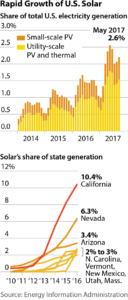IEEFA Arizona: Fast-Track Opportunities Now in Navajo Community-Driven Solar Electricity Generation

Jan. 3, 2017 — Locally owned utility-scale solar electricity generation offers Navajo communities an immediate generational economic-development opportunity, concludes a research brief published by the Institute for Energy Economics and Financial Analysis (IEEFA) and DinéHózhó.
The report— “Window of Opportunity: Navajo Solar—A Fast-Track Community-Driven Development Approach” — details how transformative changes in the U.S. electric utility industry present an opening for tribal chapter houses to negotiate mutually beneficial deals with solar-generation developers and financiers.
Solar assessments exist already, as do environmental, topography, and transmission analyses.
“Located in the center of the American Sun Belt and situated near major electricity-transmission lines, these communities are increasingly being sought out by outside interests seeking development deals crafted to meet growing demand from utility companies that are switching from fossil-fuel powered electricity to renewables,” said Sandy Buchanan, IEEFA’s executive director. “Opportunities exist now to develop these opportunities to the benefit of Navajo people.”
Tony Skrelunas, vice-president of DinéHozhó, noted that a good part of the required groundwork for solar-generation development on Navajo lands has been done already.
“These communities have a built-in predevelopment advantage in that many of these areas have been studied already for project feasibility,” Skrelunas said. “Solar assessments exist already, as do environmental, topography, and transmission
analyses. This advantage is crucial in the current marketplace.”
The brief, in addition to presenting a U.S. solar industry overview, suggests how to make well-informed, locally beneficial decisions as solar development arrives.
- Suitable assessments include predevelopment protocols that are in place in many cases already and development procedures that create partnerships that ensure tribal-chapter ownership equity in perpetuity.
- Revenue-maximization mechanisms exist now and can serve as foundations by which fair and just shared-ownership models can be put into place. Tribal-chapter development corporations can serve a key equity-ownership role. Models to avoid includes the ones that currently support the failing Navajo Generating Station and Kayenta Mine.
- Assertive and informed negotiation is crucial to ensuring that solar-development projects are built in ways that benefit, protect, and profit local communities. Reasonable stipulations included earmarked revenue for scholarship funds, employment assistance, stand-alone funding for the thousands of Navajo households that do not have electricity, and set-asides for veterans’ assistance, healthcare, and senior services.
- Strong candidates for community-owned utility-scale solar developments in Arizona include Black Mesa, Cameron, Coalmine, Dilkon, Hard Rock, Kayenta, LeChee, Leupp, Shonto, and Tuba City. Partnership requirements for these communities and others like them should include proven track records, liability protections, strong financing and cultural compatibility.
- Solar-energy electricity generation can be brought online much faster than historically conventional power generation, including coal-fired, gas-fired and nuclear plants. In most cases, predevelopment, development and commissioning can occur in less than two years.
The research brief notes that the Southwest stands apart for its contribution over the past three years to a four-fold increase in solar-powered electricity nationally, and that broad market momentum and technology advances strongly favor utility-scale solar-powered electricity generation.
Full brief: “Window of Opportunity: Navajo Solar—A Fast-Track Community-Driven Development Approach”
_____________________________
Media contact: Karl Cates, [email protected], 917 439 8225
About IEEFA: The Cleveland-based Institute for Energy Economics and Financial Analysis (IEEFA) conducts research and analyses on financial and economic issues related to energy and the environment.
About DinéHózhó: Diné Innovative Networks of Economies in Hózhó, L3C (DinéHózhó) is the first Low-Profit Limited Liability Company (L3C) incorporated within the Navajo Nation with a mission to integrate Diné culture, sustainability, conservation, and local knowledge to a locally developed economy.
RELATED ITEMS:
IEEFA Report: Kayenta Mine Is Unlikely to Find New Customers Once Navajo Generating Station Closes













